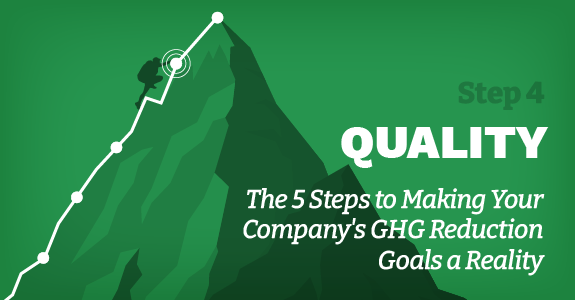
Step 4: The Power of Your Data
Using the numbers to overcome analysis paralysis and drive your decision-making with data quality.
June 8, 2022
By: Melissa Dakas, Angelique Giraud, Matt Beach, & Pen Herring
THE FOURTH IN A FIVE-STEP BLOG SERIES
In the previous steps in this series, we covered the basics of greenhouse gas (GHG) sources; some of the frameworks used to monitor, disclose, and develop a standardized plan; and the importance of accurately measuring your emissions.
In this step, we’ll talk about using the data you’re collecting to drive your efforts and influence your decisions. We’ve got a wealth of experience and technology that’s been used successfully in real-world applications for our clients, and we’re going to briefly talk about how we use this to build and run your ESG program efficiently and effectively. So where do we start?
Building an accurate picture of where your emissions are
It’s critically important to have a complete picture of your company’s total GHG emissions. Information may come from a variety of technologically sophisticated equipment, sensors, mobile units, and is fed into a data management platform such as our AirSense platform. This platform combines data from various sources to assemble an accurate picture of your emissions, and it gives you some robust capabilities in data management, reporting and customized views. When it comes to GHGs, you can’t reduce what you don’t measure!
Assess where to focus your emission reduction efforts
Once you’ve gathered your data, verified it, and determined the source and levels of your emissions, then it’s time to assign a priority and plan where your efforts will be targeted, and to what level. With the dynamic nature of the reporting and analysis, you can make real-time decisions based on how you’re progressing with your plan. As you initially tackle high-priority or low-cost projects to reduce your emissions impact, you can shift focus to other areas until you achieve your final goal.
Marginal abatement cost curve (MACC) and dynamic modeling
While some emission reduction projects are easier to implement because they are low cost or provide high immediate reductions, other projects might be harder to justify to your stakeholders. To achieve net zero goals, many of these difficult projects will be required. And if the completion timeline is long, these tasks should be started as soon as the capital is available. A MACC presents costs or savings expected from different opportunities, alongside the potential volume of emissions that could be reduced if implemented. MACCs measure and compare the financial cost and abatement benefit of individual actions. They use the metric of dollars per ton of carbon dioxide equivalent. All of this allows for dynamic modeling. Developing an accurate and dynamic model will better enable your organization to assess options consistent with your primary business objectives.
Set targets and timelines
For each reduction goal that is a part of your plan, consider a key performance indicator – a quantifiable measure of performance and a target completion date. For future target dates (> 10 years), it is important to set intermediate targets and/or milestones to drive action plans, increase credibility of long-term commitments, and give stakeholders clarity. Targets can be developed as an absolute reduction, such as a predetermined percentage of reduction in Scope 1 annual emissions, or an intensity target that allows for reductions based on a normalized business metric. By demonstrating quantifiable metrics, your organization can track your progress from your starting baseline and adjust your plan as you progress toward your ultimate goal.
Visualize your progress
One of the biggest benefits of having a data management platform is being able to monitor every step of your GHG reduction program and identify opportunities to improve success. Various platforms allow users to customize reports, use targeted dashboards to get the information views needed to make critical decisions, and see progress and report it to stakeholders accurately and in a timely fashion.
Verification
As with all data and organizational reporting, the accuracy of data is paramount. Having a verification process to validate your data and conclusions ensures peace of mind and a seamless ESG process. Ensure your platform has data verification built in and the functionality to report on this verification process.
What’s next?
In step 5, the next and final installment in this series, we’ll put all of the steps in this GHG reduction strategy and application together, with an ultimate goal of delivering on your corporate ESG promise. In the meantime, if you have any questions or comments about our capabilities and strategic planning expertise, just contact us below. We look forward to the continued conversation on this important topic, and we stand ready to assist you and your organization with getting on the path toward achieving your GHG reduction goals.
The 5 Steps to Making Your Company’s GHG Reduction Goals a Reality

QUALITY:
The Power of Your Data: Using the numbers to overcome analysis paralysis and drive your decision-making with data quality.
QUALITY Co-Authors
Melissa Dakas
Principal – Environmental Advisory Services
Ms. Dakas has 20 years of project management and solution development experience in the chemical engineering and environmental compliance fields. The last 15 years of her career have been spent in environmental consulting navigating the complex environmental requirements of the Northeast states, the Caribbean, and the Texas Gulf Coast Regions. Ms. Dakas specializes in air permitting and compliance through working with both industry and government to implement business objectives while conforming to environmental regulations.
Angelique Giraud
Environmental Research Analyst
Matt Beach
VP, Software Solutions
Pen Herring
COO, Environmental Intelligence
Pen comes to EI with over 20 years’ successful experience in leading and growing firms in the environmental industry. He has extensive leadership and operational experience in positions both domestically and internationally. He has held C-Level positions in such diverse market sectors as manufacturing, engineering, consumer & industrial products, finance, and business services. Pen is responsible for the company’s overall operations, sales & marketing, accounting & finance as well as its mergers & acquisition team. His industry experience includes successful startup experience, corporate restructuring, corporate integration through acquisitions, and organic growth through the development of technical staff into more outward facing entrepreneurs. He comes to us from an executive position at a leading environmental construction firm in California. Prior to environmental construction, Pen helped to restructure and grow a small Long Beach based environmental consulting company into a boutique consulting firm that caters to Fortune 500 clients throughout California.










